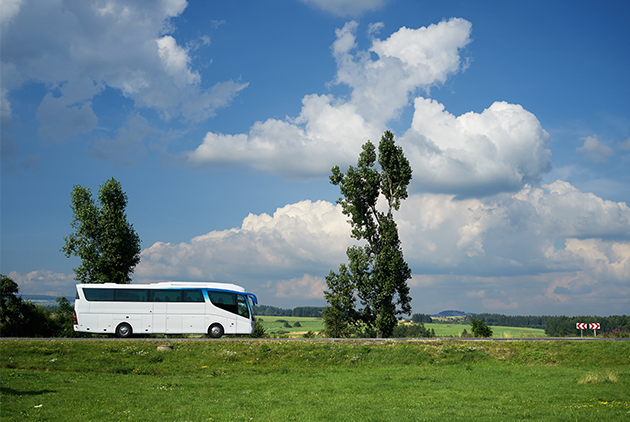World Economic Forum
Rural Public Transport Shrinks As Communities Age

Source:Shutterstock
For older rural populations, the public transport on which they increasingly depend is becoming harder to maintain.
Views
Rural Public Transport Shrinks As Communities Age
By Michelle Avaryweb only
In rural areas of Japan, the use of traditional public transport is falling dramatically due to a decreasing and aging population and a higher dependence on private vehicles. In many regions, train, buses and taxis are operating at a loss.
The situation is only expected to worsen with low birth rates and an increasing lack of drivers, as the population ages beyond the ability to drive. The ability to maintain public transport in these regions is expected to be further weakened by a shrinking tax base.
Japan is leading this trend - but she is not alone. The populations of rural areas are decreasing globally. According to the United Nations, rural population decreases will be faster in the majority of G20 countries.
Japan, on the other hand, is in a great position to lead rural mobility transformation thanks to the adoption of new technologies, a regional community with a sense of urgency to try innovative solutions, and a government dedicated to working with the private sector to find solutions.
 Rural populations are ageing across the developed world (Image: UN)
Rural populations are ageing across the developed world (Image: UN)
The World Economic Forum, in conjunction with the Centre for the Fourth Industrial Revolution’s Tokyo office, are partnering with the Government of Japan and McKinsey to answer the question:
What is required to develop sustainable mobility options for rural areas with decreasing populations?
We are taking a four-phased approach to this challenge:
1. Develop a Public Transportation Sustainability Index to help define priority areas for new mobility services and encourage local governments to accelerate transit and mobility reform
2. Identify key requirements to provide sustainable transport solutions for depopulating rural areas
3. Support new mobility solution pilots to accelerate adoption of cutting-edge technologies and identify further requirements
4. Deepen expertise on changing mobility ecosystems in Japan and develop a network of mobility providers
Transportation in rural areas is fast becoming a critical issue around the world. We need to identify areas with unsustainable public transport services and prepare them to more easily introduce new mobility solutions by showing potential transportation white spaces – that is, places in which transit options are falling, and which are consequently areas ripe for mobility innovation.
To define places of unsustainable public transit, we are looking at the current profitability of rail, bus and taxi services, as well as future demand and supply factors, and at driver availability shown by average age.
We are examining areas where there is a decrease in total demand for transit as well as identifying areas where demand for transit is dispersed and challenged; and places where mobility is regularly needed, but the static supply of traditional public transit no longer works.
We are striving to gather data to bring transparency to mobility issues, define ways to smoothly downsize traditional transportation if required, and roll out new forms of mobility that can meet the needs of citizens and businesses.
Have you read?
♦ Japan Poaches Nursing Care Personnel Abroad with High Wages
♦ Taiwan High Speed Rail: The New Benchmark for Travel Culture
♦ The Dawn of ‘Taiwan Taxi Drivers+’
A new vision for rural mobility could include:
1. Flexible operation to adapt to specific user demand: bundling different modes of transport, for example
2. Right-sized transit offerings: gather data about profitability across modes and pilot new mobility solutions including AV, MaaS, TNC, ride sharing, car sharing and carpooling options
3. Integrated multi-modal transit solutions: seamless services such as trip planning, scheduling and payments across modes
4. Proactive involvement of transit operators, residents and large regional employers: create regional solutions comprised of small villages, towns and key services and businesses such as hospitals and energy suppliers
5. Highly efficient operations to maintain services in challenged areas: consolidate back-office operations to lower overall costs
Creating solutions with diverse multi-stakeholder communities is the way forward. Our aim is to provide the critical foundation for regional communities to develop and maintain sustainable public transportation services.
With transparent data, policymakers will know where to prioritize their efforts and design solutions that work. This all needs to happen in partnership and through careful consensus-building with residents, city council members, local governments and surrounding businesses. It is our goal to create opportunities for and spur innovation in new mobility solutions.
Original content can be found at the website of World Economic Forum: As rural communities age, their public transport is shrinking. It's time to fix this
This article is reproduced under the permission of World Economic Forum (WEF) and terms of Creative Commons Attribution-NonCommercial-NoDerivs 4.0 Unported License (“CCPL”). It presents the opinion or perspective of the original author / organization, which does not represent the standpoint of CommonWealth magazine.










